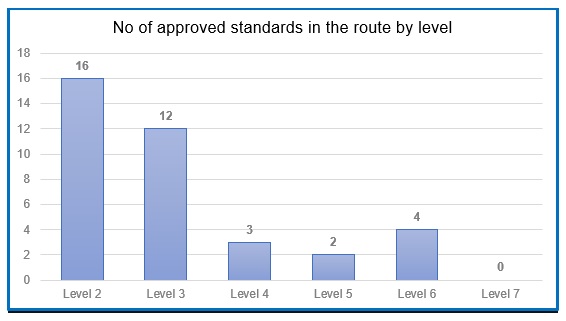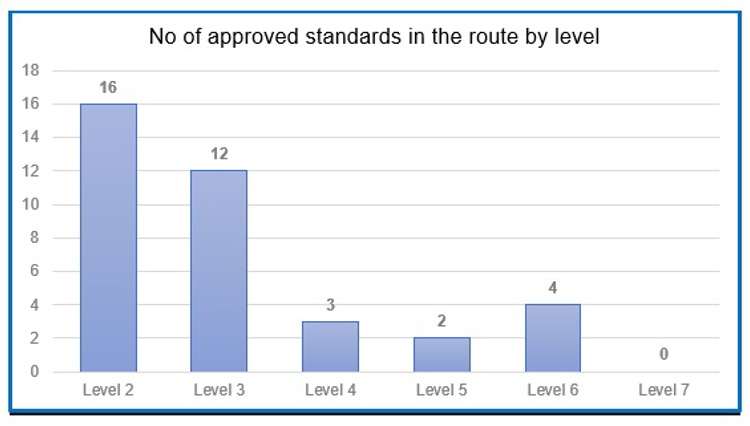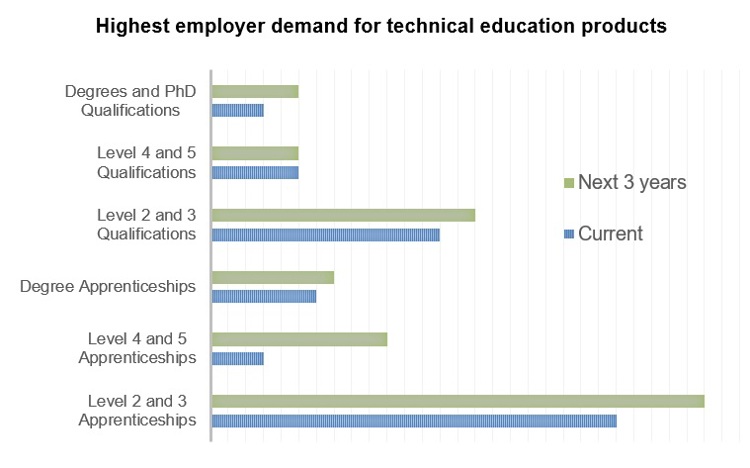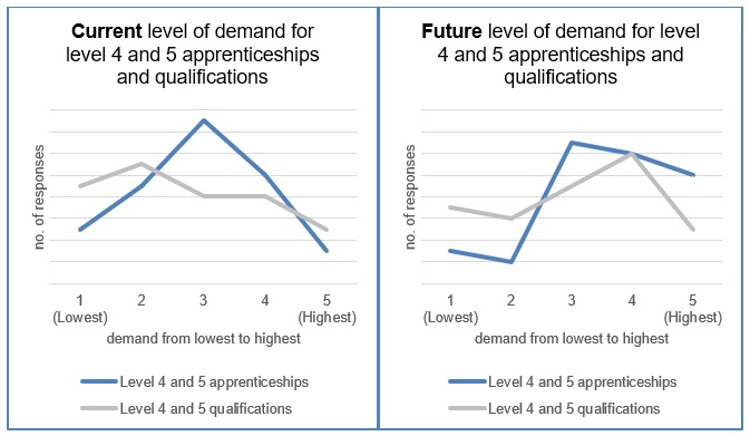Key highlights include:
The transport and logistics route review is underpinned by stakeholder consultation, with employers right at the heart.It provides a strategic look at the route, ensuring occupational standards and their content match the current and emerging needs of employers.The 7-week stakeholder consultation focused on three core themes – industry insights, emerging skills and the occupational map.The report identifies the sector challenges and priorities. These include decarbonisation and sustainability, security and acceleration of digital, technological and autonomous innovation.As a result, nine route principles and characteristics have been created and are detailed in the report. These will be used by trailblazer groups to underpin all technical education products in the route – including apprenticeships.To further support trailblazer groups, the review has used these themes to create a set of common knowledge, skills and behaviour statements.These will accelerate the time spent by trailblazer groups in developing or revising occupational standards and provide confidence that they reflect the sector needs and priorities.Over the next three years, the predicted demand in the sector for level 4 and 5 apprenticeships and qualifications is predicted to change. The consultation findings identify that high value occupations are becoming a priority for employers. The occupational map currently has five approved occupational standards at these levels. The review recommends that further work is undertaken with the sector over the next 12 months to explore this demand.The review has identified gaps within transport and logistics where new occupations may be required or approved standards in the route requiring revision. More information can be found in the full report.The report provides stakeholders with the chance to discover more about the transport and logistics occupational standards and technical education products available.If you would like to find out more about the transport and logistics route or how you can get involved with the work of IfATE, please email us.
 I am delighted to announce publication of the transport and logistics route review. This is IfATE’s seventh route review.
I am delighted to announce publication of the transport and logistics route review. This is IfATE’s seventh route review.
The aim of a review is to listen to employers, providers, stakeholders, and apprentices.
This helps us to understand the technical qualifications and skills required now and, in the future, and provides a better understanding of the workforce challenges facing employers.
Employers stand at the heart of the work we do, and we have worked with them throughout this review. I would like to thank all those taking the time to contribute. This includes our route panel members and trailblazer chairs.
They have created a close working relationship with the team to produce this report.
Your feedback is, and always will be, important to us. We want to understand how the reforms from the 2012 Richard Review of Apprenticeships are working for you.
Our 2021-2024 strategic plan, published in October 2021, focuses on three key areas:
To achieve this, we need to continue dialogue with the sector. This includes how we meet the needs of the green economy and the Government’s net zero commitments.
I am pleased to be able to present the transport and logistics route review. It aims to ensure the occupational standards in the route provide the right sector based training for a current and future workforce.
As we share the findings of this review, we hope that the sector can continue to remain resilient. This can be achieved by embracing creative solutions and expanding the use of new technical education products.
The findings of the transport and logistics route review provide the foundations for that.
I look forward to seeing how the sector embraces and builds upon this to create the future technical education landscape in transport and logistics.
Jennifer Coupland
Chief Executive
 The transport and logistics sector offers an exciting range of careers and opportunities. It includes 37 occupational standards in air, rail, road, sea and warehousing, ranging from level 2 to 6.
The transport and logistics sector offers an exciting range of careers and opportunities. It includes 37 occupational standards in air, rail, road, sea and warehousing, ranging from level 2 to 6.
As such, we are proud to be chair and vice chair for such a diverse route.
As route panel chairs, we have been able to see the positive impact that the apprenticeship programme has had on the sector and the wider economy.
Our work remains challenging as we strive to ensure technical education products in the route keep up with the evolving needs of the sector.
The UK transport and logistics sector is having to change to meet various challenges. These include digital transformation, carbon reduction and global economic change. We want to make sure the occupational standards in the route support employers to meet these challenges.
 The transport and logistics route has been busy over the last year with both new and revised apprenticeship standards. IfATE has collaborated with the route panel, trailblazer employers and other stakeholders. This has resulted in some significant successes.
The transport and logistics route has been busy over the last year with both new and revised apprenticeship standards. IfATE has collaborated with the route panel, trailblazer employers and other stakeholders. This has resulted in some significant successes.
These include four new occupational proposals approved for development. One of which includes the first occupational standard for an uncrewed vessel.
Some revisions have already commenced, addressing feedback from those delivering apprenticeship standards.
The revisions also act on the review by the Green Apprenticeships and Technical Education Advisory Panel (GATE-AP). This is to green five occupational standards in the route. They include international freight forwarding specialist and supply chain operator.
This route review has provided the opportunity to carry out a strategic review of our work to date. It produces the foundations upon which we base our future work on.
The transport and logistics route review has followed IfATE’s new approach to route reviews.
We have worked with employers throughout the review, relying on them to tell us what needs to change on the occupational map and standards.
Trailblazer chairs have played an integral part in this, and we would like to thank them for their support throughout this review.
Continued development of apprenticeships and technical education qualifications will help to address skills gaps, enable progression routes to be clearer and increase diversity.
It also supports the achievement of sustainable development goals, including net zero.
The outcomes of the route review provide us with the opportunity to produce technically future-proofed occupational standards. This will widen access to opportunities and ensure learners develop our defined set of principles.
These include having an ethical approach to work and a focus on the customer experience. It also means developing an awareness of decarbonisation and sustainability in the industry.
Finally, it is about developing a strong foundation in equity, diversity and inclusion.
The route panel commits to working with the sector, the trailblazers and providers. This will involve bringing the recommendations from the route review to fruition.
We hope that you join us in welcoming this report. It offers a great opportunity to ensure our sector has the best technical education opportunities possible.
 Neil Atkinson (route panel chair), Mark Swan (route panel vice chair).
Neil Atkinson (route panel chair), Mark Swan (route panel vice chair).
For reference: An occupational standard is a description of an occupation. It contains an occupational profile, and describes the ‘knowledge, skills and behaviours’ (KSBs) needed for someone to be competent in the occupation’s duties. Occupational standards are developed by employers for occupations that meet IfATE's current occupation criteria.Along with an end-point assessment plan (EPA) and funding band, the occupational standard is a component part of an apprenticeship.
The transport and logistics route includes occupations that involve the transport or movement of passengers, goods and freight. This can include a variety of modes such as road, rail, air and water (inland and coastal). This can be regionally, nationally, and globally.
The route also includes logistics management of goods. These can include materials, equipment, supplies and consumables. Logistics management forms a part of supply chain management and is the component that holds the supply chain together.
Multimodal transportation involves the use of more than one mode of transportation to transport and ship goods.
37 occupational standards are approved for delivery in the transport and logistics route. 4 are in development and a further 8 for consideration at time of report publication.
Beyond the transport and logistics route, the sector also has links with some of IfATE’s other routes. For example, engineering, manufacturing, business and administration, digital, sales, marketing and procurement.
In the transport and logistics route, there are:
| Level | Standards approved for delivery | Standards in development | Standards for consideration |
| Level 2 | 5 | 0 | 0 |
| Level 3 | 3 | 0 | 0 |
| Level 4 and 5 | 0 | 0 | 5 |
| Level 6 | 2 | 0 | 0 |
| Level | Standards approved for delivery | Standards in development | Standards for consideration |
| Level 2 | 11 | 0 | 1 |
| Level 3 | 9 | 1 | 0 |
| Level 4 | 3 | 2 | 2 |
| Level 5 | 2 | 1 | 0 |
| Level 6 | 2 | 0 | 0 |


The Higher Technical qualification (HTQ) approval process in transport and logistics started in 2023 with the first teaching from 2025.
HTQs are level 4 or 5 qualifications that have been quality marked by IfATE. This is to show their alignment to employer-led occupational standards.
New or existing level 4 or 5 qualifications submitted to the IfATE approvals process receive a quality mark. This is if the qualification satisfies the approvals criteria.
To date, there are no approved HTQs in the transport and logistics route and no occupational standards in scope.
You can find information on the occupational standards in scope, and the timelines for submission cycles on our website.
The government is also committed to making study options clearer at level 2 and 3 for students aged 16 and over.
IfATE has an approvals process that sets clear expectations of Level 3 qualifications. The employer voice is a key part of this. This is because technical qualifications need to be aligned to occupational standards.
The route review focuses on creating a route for learners, employers, and stakeholders that includes apprenticeship and technical education qualifications in conjunction with the occupational maps.
Route reviews are an opportunity for IfATE to listen to employers and other industry stakeholders.
They take a strategic look at the 15 technical education routes. This is to ensure that the occupational standards meet the needs of employers.
The reviews also offer the opportunity to identify emerging and future skills.
They also highlight whether technical education programmes remain relevant and up to date. The route review can also lead to identification of new opportunities.
This can help to continue to deliver the requirements of both employers and learners.
Each review is guided by four key principles:
The announcement of the transport and logistics route review was made at a trailblazer chairs’ meeting in September 2022.
A 7-week consultation launched on 22 September.
The route review consultation focused on three core themes:
The route review has been undertaken by IfATE. Employer and stakeholder insights, engagement and feedback has led every stage of this.
The route review included four stages:
The public consultation phase included the design and launch of a 20-question online questionnaire.
It also included the delivery of five employer and stakeholder webinar sessions. These each focused on a different mode. These included (rail, aviation, logistics and warehousing, maritime and road).
IfATE hosted the webinars in collaboration with professional institutions and trade bodies.
This phase analysed the quantitative and qualitative consultation responses. The initial findings were then shared with the trailblazer chairs and route panel members.
This stage also included evidence-based desk research. The research focused on the latest thinking and publications by the sector.
Findings were then used to determine three route review outcomes and route recommendations. These were again, shared with trailblazer chairs and route panel members.
This may include revision and updating of existing standards and analysis of new possible occupational standards using IfATE’s pre-proposal process.
It will involve working with trailblazer groups. These groups will adopt the new route principles and characteristics. They will also use the common knowledge, skills, and behaviours in their new and existing occupational standards.
Underpinning this will be the continuing collaborative work with professional institutions and trade bodies. This will ensure that the recommendations reflect the latest thinking in the sector.
The route review has been an opportunity for us to share insights with others. This has included IfATE colleagues, trailblazer groups and employer stakeholders.
We have also engaged with the Department for Transport to align the work with the Transport Employment and Skills Taskforce (TEST).
This enables collaborative working in delivering apprenticeships and technical education. It also presents potential opportunities and solutions to support employers in the sector.
The UK has set a target to achieve net-zero carbon emissions by 2050 and skills will play a big part in this. The government plans to create and support two million good quality green jobs by 2030 to help the UK to transition to net-zero.
In 2021, transportation was identified as being the largest sector of greenhouse gas emissions in the UK. So, sustainability and decarbonising the sector is a priority.
In aviation, Jet Zero Strategy, is a critical aspect of the future of the sector. To achieve Jet Zero by 2050, the focus is on developing sustainable aviation fuels (SAF) and zero emission flight (ZEF).
The sector is also ensuring emerging technologies forms part of this sustainable approach to air travel. These technologies include drones and electric vertical take-off and landing air craft.
Air quality emissions and noise from aviation can impact local communities. Addressing these impacts are a part of the commitment to a sustainable future for the sector.
Likewise, the UK maritime sector has made a clear declaration to step up its ambition. This was in the Declaration on Zero Emission Shipping by 2050, alongside 13 other states.
The UK government also signed Getting to Zero Coalition’s Call to Action, alongside 200 other industry leaders.
Security threats are becoming increasingly sophisticated and frequent across the transport and logistics sector. Prioritising the response to better expect and respond to them is of importance.
Maritime security is one of the seven fundamental themes of the maritime 2050 navigating the future strategy.
Maintaining security of UK waters, intelligence led automated systems and surveillance technologies need people with the relevant knowledge and skills.
Again, technologies in passenger and cargo screening play a part in ensuring greater security and resilience at ports and on ships.
In UK aviation, according to Flightpath for the future, the security strategy is being reviewed to focus on strengthening and amending domestic regulations and ensure security activity stays ahead of threats to aviation.
Innovative screening technologies, for example, are being used to provide a digitised and autonomised clearance system.
As well as consideration over data, asset and infrastructure security, physical security of people is of an equal threat. For example, commercial large goods vehicle drivers on UK roads can be at increased risk as they can be targeted for goods or vehicle theft.
Commercial vehicles can also be used in organised crime and antisocial activities, not known to a business.
According to Maritime 2050, there is also an increased threat of piracy. As such, it has led to measures such as armed guards on UK ships that transit through high-risk seas.
Technology and digital innovation interconnect. They act as an enabler of accelerated change in transport and logistics.
They also provide opportunities in all other priority areas. These include sustainability, customer experience and data analytics.
In the rail sector, many opportunities are already realised. According to Great British Railways – The William-Shapps Plan for Rail. predictive technologies led by artificial intelligence (AI) can lead to new ways of working.
This includes smarter planning, forecasting, on board digital signalling and gateless ticket lines. For rail freight, it can include digital in cab signalling.
Aviation's flightpath to the future 10-point plan also highlights the importance of embracing innovation. This includes capturing the potential of new technologies in aviation.
Meanwhile, advances in warehousing and supply chain technologies, are already changing the ways of working in the industry.
Advances have been made in the development of;
CILTUK have established a Warehouse Technology forum. The forum has a mission to review warehouse design and operation. It also considers the appropriate use of technology and materials handling.
Many of these innovations are already in pilot stages or full operation by employers. They advance at pace and so the sector needs to ensure that its people have the right capabilities and developed knowledge and skills. This will help maintain momentum and growth in developing ways of working.
The route review includes the development of nine route principles and characteristics.
These are sector defined themes that trailblazer groups consider for inclusion in the development of all transport and logistics occupational standards.
Principles are applicable to all occupations in the route.This includes existing occupations on the map which are being revised and new occupations in development.The principles are relevant to all technical education products. This includes apprenticeships, HTQs, T-Levels and Level 2 and 3 qualifications.
Characteristics may be common across many standards and their knowledge, skills, and behaviours (KSBs).Trailblazer groups will consider the relevance of these characteristics for their occupational standards. Where appropriate, they will include them in the knowledge, skills and behaviours (KSBs).
The nine Principles and Characteristics for the transport and logistics route are:
Data shows that current workforce demographics in transport and logistics are not reflective of today’s diverse society.
This identifies the need for more action to address potential barriers and promote equity, diversity, and inclusion (EDI) in the sector.
The public apprenticeship data for the transport and logistics route (based upon all time starts (Feb 2023) includes:
| Gender | Ethnicity | Learners with learning difficulties or disabilities (LLDD) |
| 17% female | 20% other than white | 10% LLDD |
| 83% male | 80% white | 90% Not LLDD |
The sector also recognises the need to adapt workplace cultures and environments. This is to address unconscious bias, ensuring that policies and practices support equity, diversity, and inclusion (EDI) and reflect the UK’s diverse population.
The sector has emerging roles and technologies. Fulfilling these with a diverse and inclusive pipeline of talent is the best way to achieve this.
Many initiatives have been and continue developing to address this.
They aim to promote a more equitable, diverse, and inclusive sector. Some of which include:
Diversity in Maritime programme
This is open to the UK railway industry to sign up and promote positive change in relation to EDI.
This aims to attract diverse and talented people and inspire the next generation.
Women in Aviation and Aerospace Charter
The big logistics diversity challenge
In transport and logistics, initiatives have primarily focused on gender as the priority characteristic. Yet, there is now recognition of other protected characteristics, with new initiatives emerging.
To ensure that the route continues to encourage and support equity, diversity, and inclusion (EDI) across the sector, it is important that trailblazer groups describe occupations in a way that is accessible to, and inclusive of, those from all backgrounds.
It is also important to consider how they can enable people from a range of backgrounds and regions to take up an apprenticeship or technical education product.
As a decision maker, IfATE commit to the pursuit of equity, diversity and inclusion in education.
IfATE has created an equity, diversity and inclusion (EDI) strategy framework and toolkit. It supports trailblazer groups and puts EDI consideration into the forefront. From developing and approving, to reviewing occupational standards, apprenticeships and technical qualifications.
IfATE will improve access to technical education, through a simpler skills system that works for everyone.
The fundamental priority in the movement and transportation of people or goods is that everyone remains safe and secure.
Maintaining world leading safety standards in transport and logistics is a major priority. As such, the sector is heavily regulated to maintain a world leading safety record.
As the sector modernises and evolves, safety regulations will be continually reviewed. This is to ensure that they remain fit for purpose and are flexible enough to allow for emerging technologies and modern methods.
Safety is a fundamental principle of the transport and logistics route. This must be adopted into occupational standards and throughout all technical products.
IfATE has a part to play to meet the requirements of the various industry regulators. The competency definitions in our occupational standards should reflect those defined by the sector.
Trailblazer groups should ensure that they include knowledge, skills and behaviours (KSBs) relevant to the necessary safety and regulatory requirements in their occupational standard and are as up to date as possible at the point of submission.
Customer service is at the heart of any successful customer focussed product or service-based industry.
The transport and logistics sector are extending their focus beyond good service. They do this by considering the customer experience, which is crucial to competitiveness.
The sector recognises that customer experience is not solely focused on servicing the customer.
Instead, it is about taking a systems thinking approach, considering how a service engages with its customers at every point.
This can be in their travel journey or in the movement and delivery of a customer’s goods.
In effect, the sum of all interactions a customer has with a product or service and how these interrelate with one another.
This is evident in one of our standards which is currently in revision, Passenger transport driver - bus, coach, and tram.
The trailblazer group emphasised the changing recognition of the term 'customer' as opposed to 'passenger' within the industry.
For example, a good customer experience is having;
It also involves transparent, consistent, and easily accessible channels of communication.
The sector has learned lessons from the COVID-19 pandemic and is now focussed on building upon these practices as customer demand increases and expectations change.
It is also about considering the right balance of human and digital touch points within the customer experience and what they look and feel like.
This is why considering customer experience is important within the transport and logistics technical education products.
It will ensure trailblazers consider building the right knowledge, skills and behaviours to support learners to be able to focus on the whole customer experience, delivering in an efficient and effective way.
Good customer experiences are underpinned by clear communication.
Maritime UK has a national priority to position the UK as leader in innovation across decarbonisation, automation, and digitisation.
Developments such as smart ports, autonomous, high-tech vessels, digital systems, and seabed mapping all need innovative thinking. They also need the knowledge and skills to introduce and operate new technologies and digital systems in the maritime sector.
Maritime UK state of the maritime nation report recognises that the UK cannot innovate and be a world leader in maritime technologies without the right people.
The pace of this change and scale of innovation will only increase over the next 10 years.
This requires the sector to focus on continuous improvement and investment as a priority not only in its physical and technological assets but also in its human capital and capabilities.
Whilst the sector has already seen the introduction of many new systems and technologies, what it does recognise is that new technologies also need a different set of knowledge and skills to understand, install, manage, control, and operate them.
Incentivising innovation to create a technology-driven transport service is also a focus of government plans for rail.
This requires the right knowledge, skills, and behaviours to make the most of emerging technologies and innovative approaches.
These will deliver improved customer experience and long-term improvements in the rail sector.
In aviation, governments flightpath to the future 10-point plan, highlights the importance of embracing innovation and capturing the potential of new technology.
With a clear agenda for transport and logistics to increase innovative solutions for the future, it is only right that continuous improvement is considered as an integral part of transport and logistics technical education products.
In 2021, transportation identified as being the largest sector of greenhouse gas emissions in the UK.
Air quality emissions and noise from aviation can impact local communities. Addressing impacts such as these are part of the sector’s commitment to a sustainable future.
This commitment also includes meeting and influencing global decarbonisation ambitions. The UK has committed to the International Aviation Climate Ambition Declaration alongside many other states.
This represents nearly half of global emissions to advance actions to reduce aviation CO2 emissions. This is at a rate consistent with efforts to limit the global average temperature increase to 1.5°C.
In June 2022, the Maritime Skills Commission released their 'Skills for Green Jobs' paper.
This sets out seven actions, including overseeing the development and deployment of a green jobs and skills matrix in the sector.
By 2040, the road freight sector must achieve net-zero. This includes supporting wider environmental ambitions including air quality and habitat preservation. An example of this is accelerating the roll out of zero emission Heavy goods vehicles (HGVs).
The Future of Freight plan acknowledges that investment and prioritisation of freight has at times led to transporting it in less sustainable ways. This is due to cost, speed and reliability considerations.
This leads to greater acknowledgement of the value of end-to-end freight journeys. Infrastructure investment and decision making is increasingly taking consideration of intermodal links and cross-modal dependencies.
IfATE recognise the importance of integrating ‘sustainability’ into the development of all new and updated apprenticeships and technical qualifications.
This is to support the UK in achieving its commitment to national and international sustainability goals.
IfATE has published a Climate Change and Environmental Skills Strategy and Action plan as well as a sustainability framework.
This sets out the key themes for all employers to consider, no matter what sector they are in.
It ensures trailblazers consider how every apprenticeship can contribute to climate change goals.
Business ethics are standards that govern the conduct of an organisation and its people. Integrity is an individual’s ability to adhere to those standards with honesty and morality, sharing common values.
Many organisations and professional institutions have their own code of ethical conduct which aligns with organisational or professional values.
Ethical practices incorporate other transport and logistics route characteristics including equity, diversity and inclusion, safety, regulation and security.
When travelling, protection of customer and user rights, safety and security are all a priority to the UK transport and logistics sector.
Following the COVID-19 pandemic, customer confidence and trust in the sector was and continues to affect people.
Whether that be issues of punctuality and reliability across modes transport or the need to deliver improvements for social and environmental benefits. For example, better regional connections between transport modes or sustainable and fuel-efficient journeys.
Customer trust was something described in the 2019 Williams Rail Review – trust in train operators.
It highlights three aspects of passenger trust.
It is important that those working in organisations understand what the reporting methods and options are and how to speak out through whistleblowing policies.
Trailblazers should consider what ethical practice looks like in their standards and knowledge, skills and behaviours (KSBs).
Physical security is the protection of people, property, and physical assets. Digital security protects the digital infrastructure such as technology and data from cyber-attacks. Whilst advances in technology offer opportunities, they also present new security challenges.
Having the latest knowledge, skills and behaviours in all occupations on the map will help to prepare for:
Maritime security is one of the seven fundamental themes of the maritime 2050 navigating the future strategy.
It states that to maintain security of UK waters, intelligence led automated systems and surveillance technologies need a specific set of knowledge and skills.
Again, technologies in passenger and cargo screening play a part in ensuring security at ports and on ships.
Global shipping route security needs managing to preserve freedom of navigation. It is also needed to deter acts of aggression to continue imports of essential goods.
UK critical national infrastructure is at increased risk. As such, the provision of maritime cyber security solutions is growing.
Maritime crime and exploitation are becoming more complex. This includes activities such as smuggling, and people trafficking.
According to Flightpath to the Future, the UK Aviation Security Strategy is being reviewed. This is to focus on strengthening and amending domestic regulations and ensure security activity stays ahead of threats to aviation.
Complex global supply chain systems, store data and information and share this through many systems.
This offers many points were sensitive information and data are susceptible to a cyber-attack.
The more links in a supply chain, the more vulnerable the data is. This can include personal data, delivery and arrival dates, locations or operational data. This can relate to air, ground, and maritime cargo transportation.
IfATE has published the Digital Skills Framework. This is to help trailblazer groups develop digital content for their occupational standards.
It will be important for trailblazers to use the framework. with particular focus on organisational security and handling data securely.
The Health and Safety at Work act 1974, describes employee welfare in the workplace as the provision and maintenance of a working environment, so far as is reasonably practicable, safe, without risks to health, and adequate as regards to the facilities and arrangements for welfare at work.
This means having the right workplace facilities and a safe and productive environment. It is also about having support in place for vulnerable employees.
The Workplace (Health, Safety and Welfare) Regulations 1992 set out a wide range of issues to consider.
Wellbeing and welfare are intrinsically linked. The right welfare considerations in place go some way to support a person’s wellbeing.
The review consultation and desk-based research indicates an increased focus on wellbeing and welfare. This is following challenges during the COVID-19 pandemic.
As a public facing sector, transport and logistics had to ensure that goods and services continued to move throughout the pandemic, operating under social distancing guidelines.
The Merchant Navy Welfare board (MNWB) work with the Maritime and Coastguard Agency (MCA) and Department for Transport (DfT) with a focus on improving the welfare of seafarers and fishers visiting UK ports.
The sector recognises that working at sea can be challenging and has several factors to consider.
These include long periods of time separated from family and friends, extended and irregular work patterns, hospitalisation abroad, loneliness and working in challenging weather conditions and extreme temperatures.
In supply chain, lorry driving can also be a remote occupation, often away from home for long periods, travelling throughout the UK and internationally to unfamiliar places.
It is recognised that to better support driver welfare and wellbeing, improvements and safer rest areas and roadside facilities are required.
Likewise, in warehousing, wellbeing and welfare are an increasing priority, acknowledging the need to create warehouses as people centric spaces, promoting a positive culture, healthy lifestyle and providing an energising and safer environment to work in.
Whilst wellbeing and welfare may be considerations for those working within transport and logistics, parts of the sector also extend this to wellbeing and welfare of their customers.
For example, in aviation, airlines and service providers are required to consider the welfare of their passengers, ensuring the welfare of passengers in situations of disruption. This was evidential during COVID-19 when the sector had to put in place steps to protect public health.
The pandemic has exposed the practical demands faced by aviation, rail, and other public transport modes in protecting the health and welfare of passengers and managing the potential health and welfare impact of UK and international travel.
Apprentices need ongoing support to ensure their wellbeing and welfare needs are being met. It’s important that the training provider, the employer and the apprentice take a collective approach to ensure that this happens
IfATE has developed ten simple steps for training providers and employers. These are to help create supportive learning and work environments for apprentice wellbeing.
The Department for Transport (DfT) recently published a summary of responses for the Department for Transport (DfT) Transport and Labour market skills call for views and ideas
These emphasised skills needed in roles that were not the traditional jobs that the public associate with the transport sector. These included the need to develop skills in data analytics.
Flightpath to the future also explains that as the aviation sector modernises, it needs to draw on a wider range of skills,.
This includes artificial intelligence and data management.
The review consultation identified five different types of data skills which the sector recognised within their emerging skills requirements.
These included;
The sector distinguished the importance of each, with particular interest in data analytical advancements as a priority for the sector to have the required knowledge and skills capability to be able to examine data sets and draw conclusions.
Aviation data analytics unleash information and knowledge to help the industry to address areas of challenge.
In their policy document, ‘Reinventing the Wheel’, Chartered Institute of Logistics and Transport (CILT UK) discuss the move towards open data and co-operative systems in transport organisations. This makes operational and performance data available through application programming interfaces for third-party use.
They outline the potential of big data for commercial transport planning in intelligent transport systems. This enables all the different data sources to link and provide smoother traffic patterns and dynamic road management.
In rail, the Great British Railways report outlines 10 outcomes to deliver on its vision.
These include;
There are several data related occupations within IfATE’s digital route.
These can be possible occupations to support transport and logistics companies.
IfATE has also published the Digital Skills Framework. This is to help trailblazer groups to develop content at all levels of occupational standards.
To support trailblazer groups in integrating these principles and characteristics into the occupational standards, a suite of common knowledge, skills and behaviour statements have been created against these nine themes.
These will benefit trailblazer groups providing a useful start point when developing or revising future occupational standards and accelerating the development time of their standards.
Apprenticeships, T Levels and HTQs are technical education products based on occupational standards.
Each occupational standard sets out the knowledge, skills and behaviours required to demonstrate competence in any occupation.
The 37 transport and logistics occupational standards are set out in an occupational map.
The map groups occupational standards which have related knowledge skills and behaviours into pathways, to make it easier to view the opportunities for career progression within the route.
There are two pathways in the transport and logistics occupational map:
The online public consultation that formed part of the route review, asked respondents for their views in relation to the title of the occupational map and its current pathway groupings.
Two feedback strands emerged from these responses which included: -
This response provides the first recommendation of the route review.
Whilst the public consultation indicated that most respondents, felt that the route name and pathways were correct and accurately reflected the transport and logistics sector, respondents did also offer a set of qualitative responses, which included alternatives and suggestions about how these could be clearer and more reflective of the sector.
It is important to IfATE that we listen and act on these employer responses. As such, in the next six months of publication of the report, IfATE will conduct an options appraisal, exploring potential to broaden transport and logistics route pathways.
The aim of this will be to understand how we best support stakeholders in differentiating and distinguishing the route occupations within the various transport modes and disciplines.
IfATE will undertake this options appraisal by working collaboratively with professional institutions, trade bodies and trailblazer groups and will present the final options to route panel for discussion and decision.
The consultation response highlights a continued increase in demand for level 2 and 3 apprenticeships and qualifications over the next 3 years in transport and logistics.
Yet, there was a distinct pattern change between current and 3-year employer demand. This suggests an increase in recognition by employers for higher and professional occupations at level 4 and above in the sector.
The employer demand for level 4 and 5 apprenticeships saw the biggest increase over the next 3 years. This was more than all other levels and technical education products.
The occupational map currently has five approved Level 4 and 5 and four Level 6 occupations. This identifies the need to explore the potential increase in demand for higher level qualifications in the route. This will help us to better understand how the route can prepare to meet this increase in demand.

| Option selected |
Increased demand in next 3 years |
| Level 2 and 3 apprenticeships | 21.80% |
| Level 4 and 5 apprenticeships | 233.80% |
| Degree apprenticeships | 16.60% |
| Level 2 and 3 qualifications | 15.30% |
| Level 4 and 5 qualifications | 0% |
| Degrees and PhD qualifications | 66.60% |

| low demand | high demand | ||||
| 1 | 2 | 3 | 4 | 5 | |
| Level 4 and 5 apprenticeships | 12% | 21% | 36% | 24% | 7% |
| Level 4 and 5 qualifications | 22% | 27% | 19% | 20% | 12% |
| low demand | high demand | ||||
| 1 | 2 | 3 | 4 | 5 | |
| Level 4 and 5 apprenticeships | 7% | 5% | 33% | 30% | 25% |
| Level 4 and 5 qualifications | 18% | 15% | 23% | 31% | 13% |
IfATE has incorporated this recommendation into their 2023/24 route strategy and will work with DfE and build upon their collaborative relationships with employer representative bodies and DfT’s Transport Employment and Skills Taskforce (TEST) to fully understand the anticipated growth of Level 4, 5 and 6 demand and how IfATE can best support this.
This could include the development of new occupational standards, expanding the range of technical education products, including Higher Technical Qualifications (HTQ’s) or improving cross route awareness of occupations in routes such as digital, business administration, engineering and manufacturing and sales and marketing and procurement.
As an extension to our second recommendation, IfATE wish to build upon our engagement with sector stakeholders and trailblazer groups, focusing on how we communicate in relation to other technical education products and how these products can potentially support the route and its options for technical education besides apprenticeships.
One of the three themes of the consultation questionnaire included 13 questions about the occupational map and its associated occupational standards.
The responses showed that:
Respondents also provided insight about which occupations on the map were not well used and possible reasons why. This has enabled us to prioritise the following occupational standards on the map for revision.
8 occupations were suggested for revision including:
1 potential occupation was recommended to be moved to the agriculture, environment and animal care route:
Respondents also suggested possible new occupations which are not currently on the map.
Further analysis of these responses, identified that 8 of these suggestions for potential occupations, already existed in current standards. Some of which sit in the transport and logistics route, some in other routes.
Also, 9 potential occupational areas were suggested for further investigation and possible development which will now be explored further by IfATE.
This will be undertaken by IfATE in collaboration with various stakeholders. These include trailblazer groups and will follow, where required, the IfATE approvals process.
Trailblazer groups will work with their assigned senior product manager to put in place the recommendations from the review. They will also embed the principles and characteristics and use the common knowledge, skills and behaviours (KSBs).
IfATE has been working with trailblazer chairs throughout the review. Many have already commenced this work, with others planned over the next 12 months.
IfATE will continue to build and develop the relationships with professional and industry sector bodies and the Department for Transport’s, Transport Employment and Skills Taskforce (TEST).
This will help to ensure further insights and exploration continues.
Sector intelligence and employer engagement helps to deliver longer-term recommendations for the route.
Any revisions or proposals of new occupations which are a result of the route review will go through IfATE’s submission and approvals processes.
We recognise that, because of the route review, trailblazers will be undertaking large volumes of work.
This will be to strengthen and future proof occupational standards within the route. IfATE will endeavour to support trailblazers throughout this process.
As part of the strategic plan, IfATE commits to promoting a continuous improvement philosophy. We will take new approaches to ensure all our customers have good experiences with IfATE.
To support the development and delivery of review recommendations, IfATE commits to supporting trailblazers by;
Maximising the transferability of apprenticeship standards by ensuring trailblazer groups represent all types of employers.
The diverse range of employers within the transport and logistics route means that it can be challenging to develop occupational standards that meet all their needs.
IfATE will support trailblazer groups to ensure they represent all types of employers, under the current policy on trailblazer group formation. This includes small and micro businesses besides larger employers.
Supporting the delivery of apprenticeship training and end-point assessment by ensuring training and assessment providers are included in trailblazer group membership.
The diverse nature of many of the occupations in the route can make it difficult for employers to attract training providers and end point assessment organisations with the required level of skill and experience.
It can also make it hard for the training and assessment to be commercially viable, given the relatively low numbers on some apprenticeship standards.
IATE will ensure that all standards within the route follow the current policy on trailblazer formation. This requires trailblazer groups to include training and assessment providers.
Working with employers to ensure technical education qualifications are performing.
IfATE commits to working with employers to promote the range of technical education products available and how they can provide new opportunities within the route.
IfATE wants products to be successful, providing exciting careers for apprentices and learners. This is as well as providing a pipeline of future talent for employers.
We will work with trailblazer groups during development and in the delivery phase to review performance and track take up.
We will then work with them to take the necessary actions to ensure greatest take up of the apprenticeship or technical qualification.
Working with employers to promote transport and logistics apprenticeships and technical education products to a diverse audience.
Apprenticeships and technical education products provide an opportunity to broaden recruitment into transport and logistics occupations helping to make the industry more representative.
This is particularly true for under-represented groups. These groups may have once found it more difficult to access transport and logistics careers.
Working with employers to meet the 2050 net-zero carbon emissions target.
Employers are considering how to reduce the environmental impact of their sectors. This can include carbon offsetting or reduced waste.
The UK has a target to achieve net-zero carbon emissions by 2050, building a greener country in which skills will play a key part.
The government is now planning to create and support two million high quality, green jobs by 2030 to support the UK to transition to net-zero.
IfATE set up an advisory panel to ensure that apprenticeships and technical education are front and centre of this ambition.
The approvals process for all technical education will ensure they meet the needs of employers within the growing green economy.
This includes the creation of new standards to reflect new occupations that may contribute to meeting the challenge to reach net carbon zero.
It may also consider how the content of an occupational standard takes account of the green economy where it is not the primary focus of an occupation.
IfATE’s sustainability framework supports the inclusion of sustainable development. The framework offers considerations for new and revised occupational standards at all levels.
Trailblazer groups can refer to the sustainability framework when developing an occupational standard. This helps to include sustainable development in the knowledge, skills and behaviours of an occupation.
Working with trailblazers to ensure occupational standards are accessible to a diverse audience.
IfATE is committed to supporting greater equality of opportunity across apprenticeships and wider technical education.
We want apprenticeships and technical education to drive greater equality of opportunity for all.
As such, IfATE has developed its strategy setting out their role in widening opportunity through technical education.
Its purpose is to show how we can build a skills system that supports everyone, no matter of their background. Access to high quality technical education and skills opportunities which lead to good jobs and technical careers for all.
The commitments within the strategy span IfATE’s roles as a decision maker, an authority within the wider sector, and as an employer.
As a decision maker, we commit to the pursuit of equity, diversity, and inclusion in education. Our equity, diversity, and inclusion (EDI) framework and toolkit puts EDI consideration at the forefront of how we support trailblazers . This is to develop, approve, and review occupational standards, apprenticeships, and technical qualifications.
As an authority within the sector, we will improve access to technical education, through a simpler skills system.
Supporting trailblazer groups in the development and revision of occupational standards
We recognise that employers in the sector are busy. As such, they do not always have the time to commit to working with IfATE to develop and revise standards.
IfATE has a dedicated team who can provide trailblazers with as much or as little support as they need. This helps them to develop the required documents and manage their completed submissions.
As a result of the route review, IfATE has developed a set of common knowledge, skills and behaviours. These focus on the route principles and characteristics.
This provides a useful tool for trailblazer groups. It enables them to select those most appropriate to their standard. This speeds up the development process and reduces their time commitment.
Published 2 May2023
Last updated 2 May 2023
(LM NS)